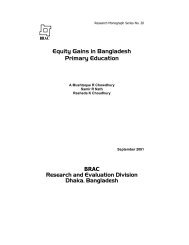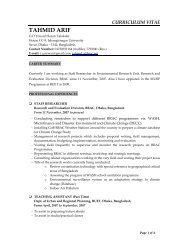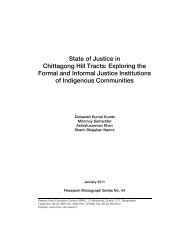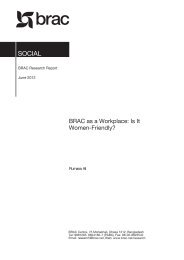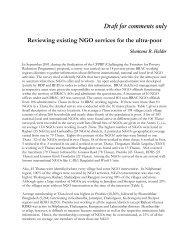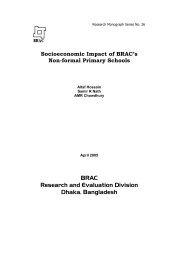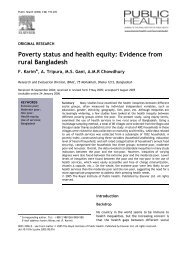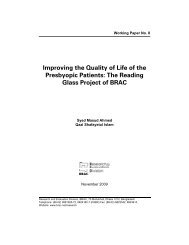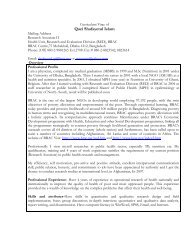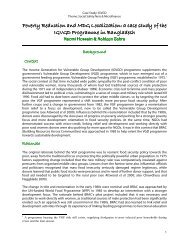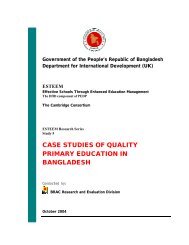Combining health and social protection measures to reach the ultra ...
Combining health and social protection measures to reach the ultra ...
Combining health and social protection measures to reach the ultra ...
You also want an ePaper? Increase the reach of your titles
YUMPU automatically turns print PDFs into web optimized ePapers that Google loves.
Access <strong>to</strong> <strong>health</strong><br />
raising public awareness of <strong>the</strong> rational use of medicines, <strong>and</strong><br />
upholding <strong>the</strong> rights <strong>and</strong> interests of patients.<br />
Streng<strong>the</strong>ning <strong>the</strong> capacity for innovation in medical<br />
science <strong>and</strong> promoting traditional Chinese medicine: In<br />
2006, <strong>the</strong> State Council issued its National Outline for<br />
Medium- <strong>and</strong> Long-term Scientific <strong>and</strong> Technological<br />
Development, listing population issues, <strong>health</strong> <strong>and</strong><br />
pharmaceutical innovation as <strong>to</strong>p priorities in science <strong>and</strong><br />
technology. With a growing cohort of medical professionals,<br />
China’s capacity for <strong>health</strong> research is also growing.<br />
Traditional Chinese medicine is an important part of China’s<br />
<strong>health</strong> system. It has played an instrumental role in disease<br />
prevention <strong>and</strong> treatment, rural <strong>health</strong> development, <strong>and</strong><br />
urban community <strong>health</strong> services. Traditional Chinese<br />
medicine has its unique advantages in h<strong>and</strong>ling difficult <strong>and</strong><br />
complicated cases, <strong>and</strong> it is an important part of China’s<br />
his<strong>to</strong>rical heritage. To foster innovation in traditional<br />
medicine, in 2007, <strong>the</strong> Ministry of Science <strong>and</strong> Technology<br />
<strong>and</strong> <strong>the</strong> Ministry of Health jointly issued <strong>the</strong> Outline for<br />
Innovation <strong>and</strong> Development of Traditional Chinese Medicine<br />
2006–2020, charting <strong>the</strong> course for fur<strong>the</strong>r development in<br />
<strong>the</strong> traditional medical sec<strong>to</strong>r.<br />
Intensifying reform of <strong>health</strong> system: In 2006, <strong>the</strong> State<br />
Council set up a Health System Reform Coordination Group<br />
<strong>to</strong> promote <strong>the</strong> development of China’s <strong>health</strong> system; <strong>to</strong><br />
address issues of access <strong>to</strong> doc<strong>to</strong>rs <strong>and</strong> hospitals; <strong>and</strong> <strong>to</strong><br />
improve <strong>the</strong> <strong>health</strong> of <strong>the</strong> people. The National Development<br />
<strong>and</strong> Reform Commission <strong>and</strong> <strong>the</strong> Ministry of Health serve as<br />
<strong>the</strong> coordina<strong>to</strong>rs, <strong>and</strong> <strong>the</strong>y are responsible for organizing more<br />
than 10 governmental bodies <strong>to</strong> address key issues in public<br />
<strong>health</strong> reform. Over <strong>the</strong> course of a year’s work, important<br />
progress has been made. We will continue <strong>to</strong> integrate<br />
governmental guidance with market mechanisms, while<br />
addressing relationships between fairness <strong>and</strong> efficiency in<br />
<strong>health</strong> system reform. It is <strong>the</strong> duty of government at all levels<br />
<strong>to</strong> improve <strong>the</strong> <strong>health</strong> of <strong>the</strong> people, <strong>to</strong> realize, protect <strong>and</strong><br />
develop <strong>the</strong> rights <strong>and</strong> interests of <strong>the</strong> people with regard <strong>to</strong><br />
<strong>health</strong>. Taking China’s realities as a starting point, China must<br />
learn from o<strong>the</strong>r countries while exploring its own way<br />
<strong>to</strong>wards <strong>health</strong> system reform with Chinese characteristics.<br />
We should focus our efforts on institutional innovation, <strong>and</strong>,<br />
at <strong>the</strong> same time, take effective <strong>measures</strong> <strong>to</strong> solve those<br />
problems that <strong>the</strong> people care about most. Efforts will be<br />
made <strong>to</strong> upgrade <strong>the</strong> <strong>health</strong> service system in rural <strong>and</strong> urban<br />
areas; <strong>to</strong> improve medical insurance <strong>and</strong> its funding<br />
mechanisms; <strong>to</strong> exp<strong>and</strong> medical financial assistance services;<br />
<strong>and</strong> <strong>to</strong> streng<strong>the</strong>n governmental supervision <strong>and</strong> regulation,<br />
enabling <strong>the</strong> <strong>health</strong> system <strong>to</strong> operate in a more efficient way.<br />
The <strong>health</strong> of <strong>the</strong> Chinese people keeps improving. The<br />
average life expectancy in China <strong>reach</strong>ed 73 years in 2005,<br />
an increase of 4.4 years from 68.6 years in 1990. The<br />
mortality rate of children under <strong>the</strong> age of 5 years dropped<br />
from 61 per thous<strong>and</strong> in 1991 <strong>to</strong> 20.6 per thous<strong>and</strong> in<br />
2006. Maternal mortality fell from 80/100 000 in 1990 <strong>to</strong><br />
41.1/100 000 in 2006. The overall heath of <strong>the</strong> Chinese<br />
people is leading that of most developing countries. Marked<br />
results have been achieved in controlling HIV/AIDS, TB <strong>and</strong><br />
malaria. The number of people with malaria has been<br />
reduced from 24 million in <strong>the</strong> 1970s <strong>to</strong> 116 000 in 2006,<br />
with malaria endemic areas now much smaller in size. China<br />
is taking effective <strong>measures</strong> <strong>to</strong> honour its commitment <strong>to</strong> <strong>the</strong><br />
United Nations Millennium Development Goals. At <strong>the</strong> same<br />
time, this is part of China’s contribution <strong>to</strong> global <strong>health</strong><br />
development.<br />
Deepening international cooperation <strong>and</strong><br />
advancing <strong>health</strong> research<br />
Since 1963, China has continuously sent medical teams <strong>to</strong><br />
more than 60 countries <strong>and</strong> areas in Africa, Asia, Latin<br />
America, Europe <strong>and</strong> Oceania, involving more than 2 million<br />
medical staff <strong>and</strong> treating more than 200 million patients. In<br />
recent years, <strong>the</strong> Chinese Government has increased aid <strong>to</strong><br />
developing countries, African countries in particular.<br />
President Hu Jintao announced at <strong>the</strong> Beijing Summit Forum<br />
on China-Africa Cooperation in November 2006 that <strong>the</strong><br />
Chinese Government will provide a grant of 300 million RMB<br />
within three years <strong>to</strong> help African countries prevent <strong>and</strong> cure<br />
malaria by providing artemisinin <strong>and</strong> setting up malaria<br />
prevention <strong>and</strong> control centres. We have provided 30 African<br />
countries seriously affected by malaria with artemisinin <strong>and</strong><br />
sponsored seven training sessions on malaria prevention <strong>and</strong><br />
control in 2006.<br />
Diseases respect no country borders, as <strong>the</strong> saying goes. It<br />
is <strong>the</strong> common wish of mankind <strong>to</strong> effectively control diseases<br />
<strong>and</strong> <strong>to</strong> improve <strong>health</strong>. With globalization gaining<br />
momentum, it is all <strong>the</strong> more important <strong>to</strong> streng<strong>the</strong>n<br />
international cooperation in <strong>health</strong>. And international<br />
cooperation promises great progress in <strong>the</strong> prevention <strong>and</strong><br />
control of communicable diseases, in <strong>health</strong> research,<br />
medical education <strong>and</strong> <strong>health</strong> systems <strong>and</strong> policy<br />
administration. The Global Forum for Health Research <strong>and</strong><br />
<strong>the</strong> World Health Organization should play important roles in<br />
guiding <strong>and</strong> facilitating international cooperation. Effective<br />
cooperation between countries is critical <strong>to</strong> our collective<br />
efforts <strong>to</strong> fight disease, <strong>to</strong> improve <strong>health</strong>, <strong>to</strong> advance <strong>the</strong><br />
progress of mankind <strong>and</strong> <strong>to</strong> uphold harmony <strong>and</strong> stability in<br />
<strong>the</strong> world.<br />
Promoting <strong>health</strong> research: All countries are now facing<br />
great challenges in <strong>health</strong> financing <strong>and</strong> ever increasing<br />
<strong>health</strong> expenditures. Currently, limited funds are available for<br />
<strong>health</strong> research, <strong>and</strong> this problem is especially pronounced in<br />
developing countries. Insufficient investments in research <strong>and</strong><br />
limited capacity for medical innovation are barriers <strong>to</strong><br />
scientific decision-making <strong>and</strong> <strong>the</strong> development of <strong>the</strong> <strong>health</strong><br />
sec<strong>to</strong>r, <strong>and</strong> <strong>the</strong>refore have a negative influence on <strong>the</strong> <strong>health</strong><br />
of <strong>the</strong> people. All countries need <strong>to</strong> step up efforts <strong>to</strong> increase<br />
investment in <strong>health</strong> research, <strong>to</strong> organize strong systems for<br />
innovative research, <strong>and</strong> <strong>to</strong> bring value products from<br />
scientific research in<strong>to</strong> production. At <strong>the</strong> same time, full use<br />
should be made of scientific evidence, <strong>and</strong> we should also<br />
work <strong>to</strong> bridge gaps between decision-making <strong>and</strong> scientific<br />
research.<br />
022 ✜ Global Forum Update on Research for Health Volume 4



